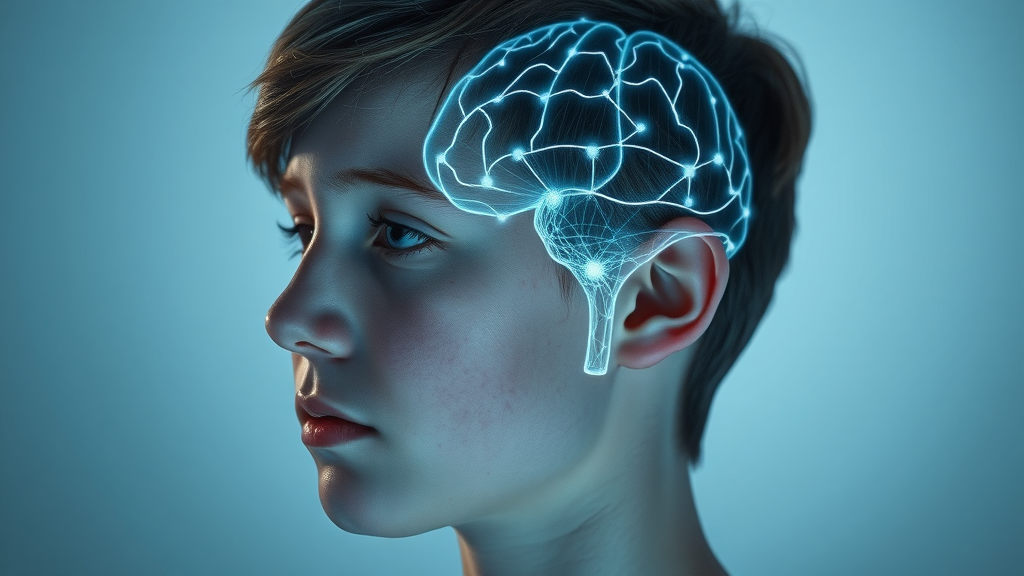Hook: Did you know that nearly one in five children in the United States has a learning disability—and most aren’t diagnosed until their teenage years? Understanding these learning differences can unlock your teen’s potential, helping to create opportunities for success for all individuals, regardless of the challenges they face. This in-depth parent resource guide covers crucial information you need, from recognizing symptoms to accessing special education services and nurturing mental health.

Understanding Learning Disabilities in Teens: Parent Resource Guide
Learning disabilities can surface in many forms during the teen years, affecting academic performance, social skills, and emotional wellbeing. For many parents, unraveling the complexities behind why their child h
as a learning struggle is daunting. But by arming yourself with reliable, practical information about learning disabilities in teens, you’ll be ready to partner with schools, seek appropriate special education services, and create opportunities for your child’s success.
The importance of early recognition and intervention is supported by research: teens affected by learning disabilities experience greater difficulty in public school settings, often struggling with time management, the ability to listen, and keeping up with a fast-paced academic environment. However, with targeted support and the right knowledge—such as understanding the differences between specific learning disabilities and learning difficulties—families can give their teens the very best chance at thriving throughout school and into adulthood.
Startling Statistics: The Prevalence and Impact of Learning Disabilities
“Nearly 1 in 5 children in the U.S. has a learning disability, and most are identified in their teenage years.” — National Center for Learning Disabilities

Statistics reveal that millions of teens in the U.S. are affected by learning disabilities, from dyslexia and ADHD to autism spectrum disorders and more. These conditions don’t just impact academics; they ripple through friendships, self-confidence, family life, and mental health. The Learning Disabilities Association of America and other experts estimate that 15-20% of the population has a specific learning disability, underlining how common and varied these challenges are. Recognizing the prevalence of learning disabilities empowers parents to seek help sooner, challenge outdated myths, and find their community among others facing similar circumstances.
What You'll Learn in This Learning Disabilities in Teens: Parent Resource Guide
How learning disabilities manifest in teens
Red flags and early symptoms for parents
Diagnostic pathways and professional help
Ways to support mental health and wellbeing
Special education services and legal rights
Resources for children with learning disabilities
What Are Learning Disabilities in Teens?
Learning disabilities are neurologically based processing problems that interfere with learning basic skills such as reading, writing, or math. In teens, these challenges may become more apparent as schoolwork grows complex and expectations rise. Unlike physical disabilities, learning disabilities are not always obvious, which can lead to confusion for both students and parents.
The learning disabilities in teens: parent resource guide highlights that these conditions do not reflect a teen's intelligence or potential. Instead, they indicate a different way of processing information. Understanding what these disabilities are, and how they specifically affect your child, is the first step in providing meaningful support, seeking effective interventions, and fostering resilience.
Defining Learning Disabilities and Specific Learning Differences

Learning disabilities encompass a spectrum, including specific learning disabilities like dyslexia (reading), dyscalculia (math), and dysgraphia (writing), as well as broader neurodevelopmental differences such as attention deficit disorders and autism spectrum disorder. These conditions all affect the way an individual processes and retains information, often necessitating unique instructional approaches and support.
The key takeaway for parents is that a diagnosis of a learning disability does not define a teen’s future. Instead, it's a guide to understanding how your child learns best, what accommodations might be helpful, and which resources—from classroom modifications to technology—will help create opportunities for success for all individuals with learning disabilities.
Distinction: Learning Disability vs. Learning Difficulties
Comparison of Common Learning Disabilities |
||
Condition |
Description |
Key Features |
|---|---|---|
Dyslexia |
Difficulty with word recognition, spelling, and decoding |
Problems reading fluently or accurately |
Dyscalculia |
Challenges in understanding numbers and math concepts |
Frequent math errors; struggles with time management involving numbers |
Dysgraphia |
Difficulty with handwriting, spelling, and written expression |
Illegible writing, slow note-taking |
ADHD |
Attention deficit and hyperactivity challenges |
Impulsivity, distractibility, issues focusing on tasks |
Autism Spectrum Disorder |
Developmental condition affecting communication and behavior |
Social difficulties, unique interests, varied learning patterns |
Nonverbal Learning Disabilities |
Spatial, visual, and social interpretation difficulties |
Struggles with organization, nonverbal cues, social judgement |
While learning disabilities are often lifelong and specifically affect a child’s ability to process academic tasks, learning difficulties may be caused by external factors like trauma, health issues, or environmental conditions—and can sometimes be temporary. Understanding these distinctions ensures that children with learning disabilities receive the targeted education services they need.
Signs and Symptoms: How to Recognize Learning Disabilities in Teens
Recognizing learning disabilities in teens starts with close observation at both home and school. Early detection is key—teens whose learning differences are identified and addressed promptly are more likely to experience academic success, positive self-esteem, and improved mental health. This section of the learning disabilities in teens: parent resource guide will help you spot the warning signs and take actionable steps for support.
Some signs may be subtle, appearing as frustration with homework, difficulty following instructions, or changes in social behavior. By knowing what to look for, parents can distinguish between normal adolescent challenges and symptoms that indicate a deeper learning disability, helping to secure specialized interventions before academic and emotional challenges escalate.
Academic Red Flags in Children with Learning Disabilities

Common academic indicators that a child has a learning disability include ongoing troubles with reading, writing, math, and organizational skills despite regular practice or classroom instruction. Teens may fall behind grade level in multiple subjects, demonstrate inconsistent academic performance, or avoid homework out of frustration.
Parents should look for patterns: repeated difficulties in spelling, confusion over basic math facts, slow or laborious reading, frequent errors when copying notes, or incomplete assignments. Even in bright teens, these struggles may persist or worsen over time. It’s essential to note that these academic red flags differ from temporary setbacks and usually require an evaluation by special education professionals to identify and address the underlying learning disabilities.
Behavioral and Emotional Markers
Beyond the classroom, learning disabilities can affect behavior and emotional wellbeing. Teens may exhibit frustration, anger, or avoidance around schoolwork, leading to increased arguments or withdrawal from family and friends. Some become anxious about tests, experience frequent mood swings, or develop low self-esteem because of repeated academic failures.
Parents might notice their teens feeling isolated from peers, showing behavioral changes around school transitions, or losing interest in activities they once enjoyed. These reactions are not signs of a lack of effort, but are emotional responses to ongoing struggles and feeling “different” from classmates. Recognizing these emotional markers and seeking support from mental health professionals—alongside academic intervention—is critical for building resilience and nurturing self-confidence in children with learning disabilities.
Mental Health Considerations for Children with Learning Disabilities
“Mental health support is as critical as educational interventions for teens with learning disabilities.” — Dr. Cynthia Moore, Child Psychologist
Mental health challenges frequently accompany learning disabilities. Teens dealing with academic frustration, bullying, or feelings of inadequacy may be at higher risk for anxiety or depression. Recent research points to increased rates of social withdrawal, self-doubt, and emotional distress among individuals with learning disabilities compared to their neurotypical peers.
Access to counseling, school-based mental health resources, and strong family support can make a profound difference. Parents should strive to maintain open communication, validate their teen’s feelings, and seek the help of mental health professionals as needed. Schools with robust special education services often provide valuable social-emotional supports—key to helping children with learning disabilities thrive both academically and emotionally.
Causes and Risk Factors of Learning Disabilities in Teens
Learning disabilities arise due to a mix of genetic, environmental, and neurological factors. Understanding these root causes can help families approach the diagnosis with compassion and an informed mindset, recognizing that a child’s struggles are not due to laziness or a lack of intelligence, but the result of complex brain differences that affect learning.
While parents cannot always prevent learning disabilities, being aware of common risk factors—such as family history or birth complications—prepares them to advocate for early assessments and interventions. This section explains what experts believe are the most influential contributors to learning disabilities in teens, as well as the ways in which environmental and physical factors may play a role.
Genetic, Environmental, and Neurological Influences

Many learning disabilities run in families, suggesting a genetic link. If a parent or sibling struggles with reading, writing, or focus, there’s a higher chance a child may also be affected. Environmental risk factors—like premature birth, low birth weight, early exposure to toxins such as lead, or traumatic brain injuries—can also impact neurological development and increase the likelihood of learning difficulties.
Family history
Premature birth
Exposure to toxins
Brain injury
Neurologically, individuals with learning disabilities show differences in how specific brain regions process information. These variations affect everything from cognitive skills to time management and the ability to listen. Understanding these influences helps shift focus away from blame, instead centering efforts on accessing support and creating opportunities for success for all individuals affected by learning disabilities.
Diagnosing Learning Disabilities: Parent's Guide to the Process
If you suspect your child has a learning disability, seeking a proper diagnosis is essential for unlocking support and legal protections. The path to diagnosis can seem overwhelming, but understanding what to expect and knowing which professionals to consult reduces stress for both you and your teen. Early, thorough assessment provides direction—guiding decisions on specialized education services, classroom accommodations, and therapies tailored to your child’s needs.
From the first concerns to the end of formal evaluation, parents play a vital role in gathering information, communicating with educators, and ensuring their child receives a fair, unbiased assessment. Learning to navigate these steps is a cornerstone of effective advocacy for children with learning disabilities.
When to Seek a Learning Disability Assessment
Seek an evaluation if your teen displays ongoing academic struggles (such as declining grades, difficulty following instructions, or avoiding school tasks), behavioral changes, or persistent frustration with learning tasks despite adequate teaching. Repeated teacher feedback, documentation of challenges over time, and comparison with grade-level expectations are also strong indicators that an assessment is warranted.
Don’t wait for problems to escalate. Timely assessment can lead to earlier interventions, which often correlate with improved outcomes in academic performance and social-emotional health. If you believe your child has a learning difficulty, act quickly by asking your public school or pediatrician about the next diagnostic steps.
What to Expect: Professional Evaluation and Testing

The evaluation process typically involves a multidisciplinary team—educators, psychologists, and sometimes speech or occupational therapists. Assessments may include standardized tests, classroom observation, interviews, and questionnaires for parents, teachers, and students. These tests are designed to measure cognitive strengths and weaknesses, pinpoint specific learning disabilities, and distinguish them from other challenges such as emotional or behavioral disorders.
Testing results form the foundation for any individualized education program (IEP) or Section 504 Plan. Parents should expect to receive a comprehensive written report outlining findings, recommendations, and next steps. Open dialogue with the testing professionals, along with a willingness to ask questions, ensures your teen’s unique learning needs are fully understood and addressed.
Key Roles: Pediatricians, Psychologists, and Educators
Diagnosing learning disabilities is a team effort. Pediatricians can screen for underlying health concerns and refer families to specialists. School psychologists and private clinicians conduct detailed learning assessments and interpret testing results. Classroom teachers provide insight about academic performance, classroom behavior, and response to different instructional methods.
“A collaborative approach between parents, schools, and medical professionals delivers the best outcomes.” When parents, special education teachers, and health experts work together, they can create tailored interventions that prioritize both learning and mental health for children with learning disabilities.
Navigating Special Education Services for Children with Learning Disabilities
After diagnosis, families must navigate the world of special education and related supports. The Individuals with Disabilities Education Act (IDEA) and Section 504 of the Rehabilitation Act guarantee students with learning disabilities access to an appropriate public school education, accommodations, and services tailored to their needs. Understanding your legal rights and how to advocate for your child is critical.
This section of the learning disabilities in teens: parent resource guide walks parents through laws, school meetings, and plan development, ensuring your teen has every resource possible for academic and social success.
Understanding Special Education Law (IDEA & Section 504)
The Individuals with Disabilities Education Act (IDEA) and Section 504 are federal laws protecting students with disabilities, including learning disabilities. These laws mandate public schools to offer education services designed to create opportunities for success for all individuals, regardless of their differences. Under IDEA, eligible students receive an Individualized Education Program (IEP) with measurable goals and tailored supports.
Section 504, meanwhile, ensures access and prevents discrimination, offering accommodations such as extended test time, modified assignments, or assistive technology. Both laws emphasize collaboration between families and schools, ensuring every student with learning disabilities has equal access to education.
How to Access Special Education Services

To access services, parents can request a formal evaluation through their child’s school or provide documentation of an outside diagnosis. Schools must assess within a set timeframe, notify parents of their findings, and, if the student is eligible, schedule meetings to develop an individualized plan. It is important for families to bring relevant paperwork, ask questions, and voice any concerns during meetings.
Advocacy groups such as the Learning Disabilities Association of America recommend keeping detailed records, documenting meetings, and understanding your child’s rights under the education act. Resourceful parents often build strong partnerships with school administrators and special education professionals to ensure their children with learning disabilities receive robust, appropriate supports.
Developing an IEP or 504 Plan
An Individualized Education Program (IEP) is developed with input from parents, educators, and relevant specialists. This document outlines your child’s present strengths and needs, states measurable educational goals, and details all the special education services and accommodations to be provided. Section 504 Plans work similarly, focusing more on removing barriers so your teen can participate fully in public school life.
Active parental engagement during plan creation yields the most supportive outcomes. Regular review meetings allow for adjustments as your teen’s needs evolve, ensuring strategies remain relevant and effective. Remember: Your voice is vital in shaping an educational program that creates opportunities for lifelong learning and growth.
Education Services and Accommodations: What Options Are Available?
Classroom accommodations
Assistive technology
Extra time for exams
Personalized support
Educational accommodations make it possible for children with learning disabilities to participate in classroom activities alongside peers. Options include resource room support, use of speech-to-text devices, tailored homework assignments, and preferential classroom seating. These services are grounded in the belief that individuals with learning disabilities are most successful when schools adapt to their learning styles, rather than expecting all students to fit a single mold.
Supporting the Whole Child: Mental Health, Social Life, and Family Dynamics
While academic achievement is important, true success for children with learning disabilities hinges on nurturing emotional health, self-advocacy, and strong social bonds. Families equipped with the tools to communicate openly, encourage self-worth, and foster resilience set the stage for confident, empowered teens.
This section addresses the unique challenges and opportunities facing teens with learning disabilities—offering guidance on mental health, friendships, and family collaboration so that every individual affected by learning disabilities has a chance to thrive on every level.
Helping Your Teen With Emotional and Social Challenges

Teens with learning disabilities may experience feelings of isolation, low self-esteem, or peer rejection. Parents can support their children by validating their experiences, facilitating friendships, and teaching positive coping skills. Encourage participation in clubs, youth groups, or extracurriculars where skills outside academics can shine, promoting social connectedness and self-acceptance.
When families create opportunities for their teens to connect with others, they help minimize the negative emotional impact of learning challenges. Local or online support groups for children with learning disabilities can also foster a sense of belonging and shared understanding—powerful antidotes to loneliness and self-doubt.
Supporting Mental Health in Teens with Learning Disabilities
Mental health should be a central part of every parent resource guide on learning disabilities. Teens may be more susceptible to anxiety or depression, particularly if their academic struggles go unrecognized or unsupported. Regular check-ins, encouragement to express feelings, and proactive access to counseling services are essential strategies.
Schools may offer on-site counselors, while community clinics can provide individual or group therapy. Teaching your teen stress management, self-care, and time management practices broadens their toolkit for managing challenges, both now and into adulthood. Reach out for help whenever emotional symptoms affect daily life.
Empowering Teens: Building Advocacy and Self-esteem
Building strong self-esteem and self-advocacy in children with learning disabilities starts at home. Teach your teen to understand their unique strengths and challenges, encourage communication with teachers about learning preferences, and celebrate all achievements, not just academic ones.
Introduce your teen to youth leadership opportunities in local advocacy organizations or peer mentoring programs. These experiences can be transformative, positioning your child as the expert in their own learning journey, and preparing them for the transition to college, work, and beyond.
Expert Interview: Parenting Teens with Learning Disabilities (featuring a child psychologist/learning specialist)
Partnering with Schools: Effective Communication and Collaboration
Creating opportunities for success for all individuals with learning disabilities requires strong partnerships between parents and schools. Open, respectful communication leads to better educational planning, swift problem-solving, and a consistent, supportive environment for your teen.
Frequent collaboration and clear goal-setting ensure that education services, accommodations, and progress-tracking all match your teen’s evolving needs. Don’t hesitate to reach out to teachers, counselors, or administrators with questions—your involvement is a proven factor in positive student outcomes.
Building a Team: Teachers, Counselors, and Administrators

Assemble a support team that includes general and special education teachers, counselors, administrators, and, most importantly, your teen. Each team member brings a unique perspective on strengths and needs, helping tailor strategies that address academic, social, and emotional growth.
Regular meetings—held at least annually, and more often if needed—allow for honest dialogue and troubleshooting. Approach these collaborations as a partnership, with shared responsibility and respect for each person’s expertise. Effective teamwork maximizes the impact of available education services and helps ensure lasting progress for children with learning disabilities.
Tracking Progress and Revising Educational Strategies
Ongoing assessment is key to ensuring supports remain effective. Review IEP or 504 Plan goals regularly, analyze academic and behavioral data, and invite feedback from both teachers and your teen. If existing strategies aren’t leading to expected growth, propose adjustments—schools are required to revisit and revise plans as needs evolve.
Parents and educators should document all interventions and their outcomes, tracking both achievements and persistent barriers. This level of accountability creates opportunities for refining approaches, securing additional resources, and ensuring individuals affected by learning disabilities reach their full potential.
Transition Planning: Preparing Teens for Adulthood
Preparation for life after high school is a crucial aspect of every learning disabilities in teens: parent resource guide. Discuss postsecondary options—such as college accommodations, vocational training, or workplace supports—with your teen and their team. Transition planning should start by age 14, focusing on self-advocacy, independent living skills, and realistic academic and career goals.
Many states, including South Carolina, have dedicated transition coordinators and resources for individuals with learning disabilities. Early engagement with transition services improves future educational, vocation, and independent living outcomes.
Navigating IEP Meetings: A Parent's Guide
Parent Resources: Learning Disabilities in Teens Parent Resource Guide Toolkit
Parents don’t have to navigate learning disabilities alone. There is a growing toolkit of books, websites, support groups, and technologies dedicated to supporting both teens and their families. The resources in this section are frequently recommended by the Learning Disabilities Association of America and other national advocacy organizations.
Leverage this parent resource guide to explore tools that match your child’s needs. Effective use of educational technology, peer mentoring programs, and summer learning opportunities can change the trajectory for children with learning disabilities.
Recommended Books, Websites & Support Groups

Key resources include the Learning Disabilities Association of America, Understood.org, the Disabilities Association of America, and specialized titles like "The Survival Guide for Kids with LD." Support groups—whether local or online—offer connection, advocacy advice, and practical tips. Engage with these resources regularly to stay informed about new research, classroom accommodations, and family support networks.
Assistive Technology and Educational Tools
Assistive technologies—from text-to-speech readers and organizational apps to smart notebooks—can be game changers for teens with learning disabilities. These tools promote independence, reduce frustration, and allow students to access their strengths more fully. Parents and teachers should explore which devices or software best address individual challenges and incorporate them into schoolwork and home routines.
Many schools provide training or access to assistive tech as part of IEP or 504 accommodations, helping students with diverse learning needs keep pace with peers.
Community Programs for Children with Learning Disabilities
Local advocacy organizations
Peer mentoring initiatives
Summer learning camps
Community-based programs create safe environments for building skills, forming friendships, and enhancing self-advocacy. Look for afterschool clubs, specialized summer camps, and peer mentoring initiatives focused on empowering individuals with learning disabilities. Many of these are coordinated through public schools or local chapters of the Disabilities Association of America.
FAQs: Learning Disabilities in Teens — Parent Resource Guide Answers
What are early warning signs of learning disabilities in teens?
Consistent struggles with reading, writing, or math, avoidance of schoolwork, frequent homework frustration, and declining self-esteem are all warning signals. Pay attention to teacher feedback, compare performance over time, and consult professionals if you notice persistent difficulties despite support. Recognizing these signs early is crucial to connecting teens with targeted special education services and mental health supports.How can parents advocate for special education services?
Learn your legal rights, initiate requests for evaluation, keep detailed records, and communicate regularly with school teams. Don’t hesitate to bring an advocate or support person to meetings, and ask for clear explanations of all education act requirements. Parents who advocate effectively create more opportunities for individualized supports and positive outcomes.What mental health challenges are linked to learning disabilities in teens?
Teens with learning disabilities are more likely to experience anxiety, depression, social withdrawal, or stress from academic pressure. Support from mental health professionals, peer groups, and family members can help mitigate emotional risks and promote resilience.How to help teens transition to college or work settings?
Begin transition planning early, focusing on self-advocacy, independence, and seeking out college disability services or workplace accommodations. Encourage teens to connect with role models or mentors who have learning disabilities and build practical life skills throughout high school.Where can parents get professional help and guidance?
Start with your child’s school psychologist or counselor, ask your pediatrician for referrals, and connect with national organizations such as the Learning Disabilities Association of America. Many communities offer free or sliding-fee counseling and family support networks.
People Also Ask: Learning Disabilities in Teens Parent Resource Guide
[[paa]]
Expert Answers to Parent Top Questions
Parents often wonder about the difference between a learning disability and a learning difficulty, the impact of mental health, and when to seek assessment. If you notice academic performance issues, emotional distress, or behavioral changes, consult your school’s special education professionals and request a formal evaluation. Remember, the right diagnosis leads to strategies that create opportunities for your child’s long-term success.
Key Takeaways from the Learning Disabilities in Teens Parent Resource Guide
Early detection and support are crucial for success
Collaboration between parents and schools is vital
Special education services provide legal rights and support
Advocacy and self-esteem matter for long-term empowerment
Numerous credible resources are available for ongoing help
Where to Get Personalized Support for Learning Disabilities in Teens
Reach out to your public school’s special education team, local advocacy organizations, or national groups like the Learning Disabilities Association of America. These resources can connect you to expert counseling, educational workshops, and supportive peer networks—creating lasting opportunities for teens with learning disabilities and their families.
 Add Row
Add Row  Add
Add 





Write A Comment